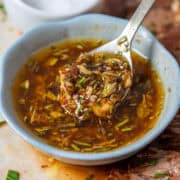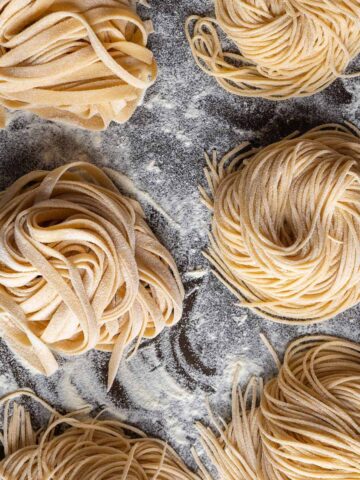What Is Self-Rising Flour?
Self-rising flour is basically all purpose flour with baking powder and some salt.
It is categorised as a low protein flour with its protein content ranging from 8-10%, depending on the brand of the flour.
The amount of protein in a type of flour determines how much gluten can be formed. The higher protein content, the more gluten will be formed when the flour is being manipulated. Gluten helps create structure and texture in our baked goods.
We want our cakes and similar baked goods to be airy and fluffy. That's why we're using self rising flour or all purpose flour. They're low protein flours.
We love our breads to be chewy, that's why we use bread flour which is categorised as high protein flour.
📮 Save this recipe for later!
Ok so now that we know a bit about self rising flour, let's see how can we make it at home without having to have several types of flours in our pantry.
How to Make Self-Rising Flour
Easy. Like I mentioned above, we will use all purpose flour, baking powder and salt.
For 1 cup (130 gr) of all purpose flour, add together 1 ½ teaspoon baking powder and ¼ teaspoon salt.
Mix well or sift them all together.
There you have it. Now don't skip any recipes that call for self rising flour just because you don't have it in your pantry. Use these other basic ingredients to make your own self rising flour.
📖 Recipe

How To Make Self-Rising Flour
Ingredients
- 1 cup all purpose flour (130 g)
- 1 ½ teaspoon baking powder
- ¼ teaspoon salt
Instructions
- Mix all ingredients well in a bowl and you can use it immediately.
Notes
- Adjust the salt amount sensibly. I would only add more salt with this ratio
- salt: cup flour 1:2
- meaning ¼ stp salt for until 2 cups flour. ½ teaspoon for until 4 cups flour.
Nutrition Facts
The nutrition facts provided are an estimate per serving. Accuracy is not guaranteed.


















Jonie says
Hi Bea. As always you have a no nonsense practical approach to cooking. From all your delicious recipes in particular the lemon loaf to your chicken dishes, everything is so yummy!!! Thanks Bea x
Bea says
Haha! Well thank you Jonie! I'm glad that you're enjoying them. XOXO
Eloisa Contreras says
Thank you so much, you’re blog really helpes me a lot
I really appriciate all you’re effort in guiding us step by step to have the perfect recipe outcome
Bea says
Thanks a lot Eloisa! I'm happy you find it useful 🙂
Fai says
Thanks so much for the tip.
However I would like to know how to turn self raising flour to normal cake flour?
Mina says
Hello Bea 🙂 .. you have an amazing website and YouTube channel.. thank you for all these useful tips and delicious recipes and keep up the good work :)...I have a question regarding this post. Most of them time, recipes that call for self rising flour also have baking powder in their ingredients..if we are making our "fresh" self rising flour for that recipe, shouldn't we reduce the amount of baking powder?
Bea says
Hello Mina. Thank you for you lovely and kind words :D. When some recipes call for self-rising flour with additional baking powder, usually it means the cake is intended to rise a bit higher, or doesn't have creaming method or it has some added ingredients like nuts, raisins etc and that extra baking powder helps to balance the weight of those. So if you want to stick to that specific recipe, what I would do is treat my homemade self-rising flour (flour, baking powder and salt) as 1 ingredient and follow the rest of the recipe (that may contain a bit more baking powder). Too much baking powder will even make the cake sinks when it cools down 😀 so sometimes a small adjustment is needed when we substitute ingredients. Hope it helps. Thanks Mina! 🙂
Mina says
Hi again Bea. Thank you very much for your detailed and professional reply. I learned a lot 🙂 ... have a great day.